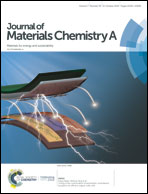Light-confining semiconductor nanoporous anodic alumina optical microcavities for photocatalysis†
Abstract
An extensive study on the structural engineering of titanium dioxide-functionalized nanoporous anodic alumina optical microcavities (TiO2-NAA-μQVs) for photocatalysis enhanced by light confinement is presented. The architecture of NAA-μQVs – composed of two highly reflective NAA-based gradient index filters (NAA-GIFs) with a physical cavity layer in between – is engineered by sinusoidal pulse anodization to tune the characteristic resonance band of these photonic crystals (PCs) across the visible-NIR spectrum. NAA-μQVs are chemically functionalized with photo-active layers of TiO2 by the sol–gel method. Photocatalytic enhancements in TiO2-NAA-μQVs are identified by monitoring the photodegradation of model organics with absorbance bands at specific positions within the visible spectral region. The performance of TiO2-NAA-μQVs under controlled visible-NIR irradiation is enhanced by resonant recirculation of light within the semiconductor PC's structure. These enhancements are found to rely strongly on the relative position between the resonance band of TiO2-NAA-μQVs and the absorbance band of model organics, and on the light confinement quality. Overall photocatalytic degradation is also dependent on the total thickness of the PC structure and the molecular steric structure of organics. Reusability and effect of the crystallographic phase of photo-active TiO2 layers in TiO2-NAA-μQVs to degrade a model organic are also demonstrated. This study provides new opportunities to develop highly performing, cost-effective, industrially scalable and reusable photocatalyst materials capable of achieving an efficient management of photons at the nanoscale to accelerate photocatalytic reactions by light confinement effect.



 Please wait while we load your content...
Please wait while we load your content...